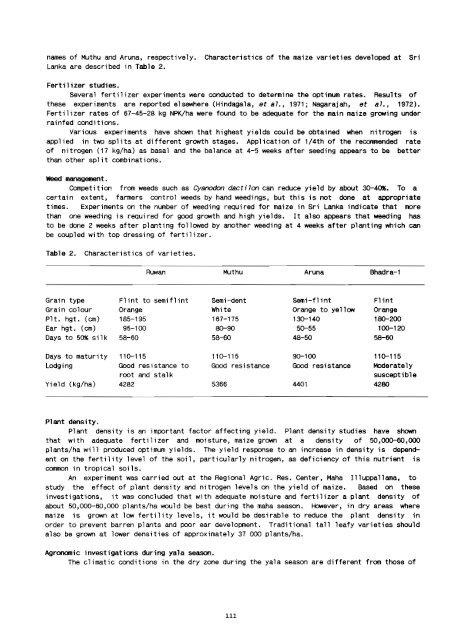Proceedings of the Fifth Asian Regional Maize Workshop - Search ...
Proceedings of the Fifth Asian Regional Maize Workshop - Search ...
Proceedings of the Fifth Asian Regional Maize Workshop - Search ...
Create successful ePaper yourself
Turn your PDF publications into a flip-book with our unique Google optimized e-Paper software.
names <strong>of</strong> Muthu and Aruna, respectively. Characteristics <strong>of</strong> <strong>the</strong> maize varieties developed at Sri<br />
Lanka are described in Table 2.<br />
Fertilizer studies.<br />
Several fertilizer experiments were conducted to determine <strong>the</strong> optimum rates. Results <strong>of</strong><br />
<strong>the</strong>se experiments are reported elsewhere (Hindagala, et a7., 1971; Nagarajah, et a7., 1972).<br />
Fertilizer rates <strong>of</strong> 67-45-28 kg NPK/ha were found to be adequate for <strong>the</strong> main maize growing under<br />
rainfed conditions.<br />
Various experiments have shown that highest yields could be obtained when nitrogen is<br />
applied in two splits at different growth stages. Application <strong>of</strong> 1/4th <strong>of</strong> <strong>the</strong> recommended rate<br />
<strong>of</strong> nitrogen (17 kg/ha) as basal and <strong>the</strong> balance at 4-5 weeks after seeding appears to be better<br />
than o<strong>the</strong>r split combinations.<br />
weed management.<br />
Competition from weeds such as Cyanodon dacti70n can reduce yield by about 30-~. To a<br />
certain extent, farmers control weeds by hand weedings, but this is not done at appropriate<br />
times. Experiments on <strong>the</strong> number <strong>of</strong> weeding required for maize in Sri Lanka indicate that more<br />
than one weeding is required for good growth and high yields. It also appears that weeding has<br />
to be done 2 weeks after planting followed by ano<strong>the</strong>r weeding at 4 weeks after planting which can<br />
be coupled with top dressing <strong>of</strong> fertilizer.<br />
Table 2.<br />
Characteristics <strong>of</strong> varieties.<br />
Ruwan Muthu Aruna Bhadra-1<br />
Grain type Flint to semi flint Semi-dent Semi-fl int Fl int<br />
Grain colour Orange White Orange to yellow Orange<br />
PH. hgt. (em) 185-195 167-175 130-140 180-200<br />
Ear hgt. (cm) 95-100 80-90 50-55 100-120<br />
Days to 50% sil k 58-60 58-60 48-50 58-60<br />
Days to maturity 110-115 110-115 90-100 110-115<br />
Lodging Good resistance to Good resistance Good resistance Moderately<br />
root and sta"1 k<br />
susceptible<br />
Yield (kg/ha) 4282 5366 4401 4280<br />
Plant density.<br />
Plant density is an important factor affecting yield. Plant density studies have shown<br />
that with adequate fertilizer and moisture, maize grown at a density <strong>of</strong> 50,000-60,000<br />
plants/ha will produced optimum yields. The yield response to an increase in density is dependent<br />
on <strong>the</strong> fertility level <strong>of</strong> <strong>the</strong> soil, particularly nitrogen, as deficiency <strong>of</strong> this nutrient is<br />
common in tropical soils.<br />
An experiment was carried out at <strong>the</strong> <strong>Regional</strong> Agric. Res. Center, Maha 11 1uppal lama, to<br />
study <strong>the</strong> effect <strong>of</strong> plant density and nitrog~n levels on <strong>the</strong> yield <strong>of</strong> maize. Based on <strong>the</strong>se<br />
investigations, it was concluded that with adequate moisture and fertilizer a plant density <strong>of</strong><br />
about 50,000-60,000 plants/ha would be best during <strong>the</strong> maha season. However, in dry areas where<br />
maize is grown at low fertility levels, it would be desirable to reduce <strong>the</strong> plant density in<br />
order to prevent barren plants and poor ear development. Traditional tall leafy varieties should<br />
also be grown at lower densities <strong>of</strong> approximately 37 000 plants/ha.<br />
Agronomic investigations during yala season.<br />
The climatic conditions in <strong>the</strong> dry zone during <strong>the</strong> yala season are different from those <strong>of</strong><br />
111

















